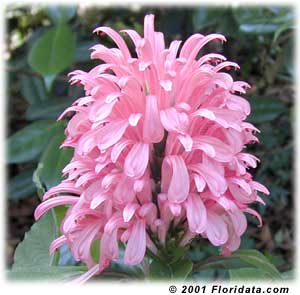
Last month I was whining about the ongoing drought that we've been experiencing here in Florida. The good news is that June brought the return of our normal summer monsoon rains - ponds are beginning to fill and all things green are growing crazy. The bad news is that all of this moisture has created a plague of mosquitoes. Still this is a small price to pay for the luxury of having actual rainfall. Even plants that I don't take care of very well are thriving (like the pink Jacobinia in the picture). So around here June was a lively, lush and fertile month with much going on. We even had a blessed event! Mathilde, our Great Dane grand dame, had babies!

Milestones: New Puppies!
After a high tech conception via uterine implant Mathilde quickly grew to humongous proportions. While she probably would have preferred the traditional method of conception, everyone was relieved that the procedure was effective. Because of her sizable dimensions we expected eight to ten puppies so we were surprised that she had only four. Sadly, one of the little fellows, a brindle male, just wasn't up for living. Although he was of good weight and appeared healthy, he kept pushing away from mom and turning cold. He was put with a hot water bottle and I let him sleep on my belly under my t-shirt but he just wouldn't warm up to life. He left the world within 24 hours of entering. It is always sad to loose a puppy. Because I am sentimental (about dogs anyway) I mark each dog's passing regardless of how long we had been acquainted. So I planted a clump of 'Heavy Metal' switchgrass above his little grave. I will think of Mathilde's little brindle boy whenever I see it waving in the breeze.
Milestone: Growing Up Big
We achieved another dog milestone last weekend when the boy, Petey, had his first lady friend come a calling. Petey performed perfectly and to everyone's satisfaction and relief the "dates" all lasted less than twenty minutes. He is now lovesick, has lost weight and pines for his beloved to return. His poor teenage dog self is trapped and tortured by the tyranny of testosterone. He has lost interest in hanging with me and no longer comes when I call. He doesn't even chase the squirrels, fetch the stick or catch the ball. Petey prefers to just patrol the places his honey previously puddled with pee. Love does strange things to all of us - you, him and me.
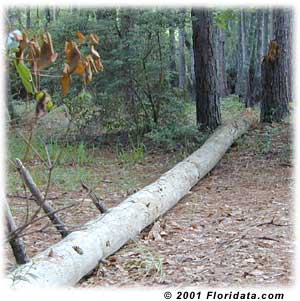
Milestone: The Fallen
It's my observation that Petey, and dogs in general, do not like changes in their environment. I know this because whenever I rearrange the furniture they get distraught and growl. I didn't growl but I did find myself becoming surprisingly bummed when recent stormy weather brought on a rash of windfall events. For weeks now, huge dead limbs have been falling from the heights. We have many trees here and lots of limbs are falling and even whole trees are keeling over without warning.
Many years ago a longleaf pine near the front of the house was hit by lightening and the following year it was attacked by pine borers. By the next year it was dead. It was a pretty ugly sight as the last of the bark fell from its skeletal trunk. The only reason that I didn't cut it down and burn the carcass was (is) because I'm lazy. As I procrastinated, the trunk cleared itself of limbs dropping them one by one until it towered like a totem above the yard. My laziness was rewarded when I realized that it had became a wildlife habitat. Old dead pine as it came to be called, hosted regular dinner parties for our neighborhood woodpeckers. It also served as hunting lookout for red-shouldered hawks with a taste for squirrel and a nesting site for some sort of bird that is too small for me to see with my not-very-well-corrected middle aged vision. So it was a minor tragedy for me and the local critters when old dead pine took a topple. Fortunately its fall caused little damage to surrounding vegetation. Unfortunately it missed my crappy house. Farewell old dead pine.
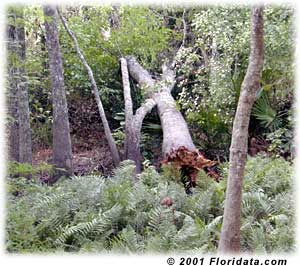
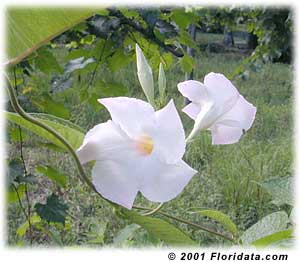
Milestone: The Fallen Too
Just days after old dead pine crashed I followed Petey down to inspect the sinkhole that we call Little Cypress Sink. I immediately sensed something was amiss. After several minutes of astute observation and keen analysis I determined that the towering tupelo tree that had once vied for sinkhole dominance with a nearby giant bald cypress had bit the dust. It had crashed into the side of the sink pinning several smaller tupelos into uncomfortable configurations. As is their nature when growing in swampy areas, this titanic tupelo had rotted out leaving its base hollow and empty. This is a disastrous tendency that structurally weakens the tree that will eventually cause collapse. In addition, this rot may extend down the tupelo's long tap root. The root becomes hollow and essentially behaves like a pipe causing the host body of water to rapidly drain. This can have unfortunate results when toxins carried by surface water use this route to flow directly into the underground aquifer. For this reason tupelo is NOT recommended for planting in retention ponds intended to reduce storm water runoff from parking lots and structures - bald cypress is a much better choice.
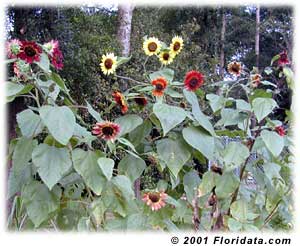
In Bloom at Floridune
It is mostly shades of green here at Floridune this time of year but some favorite summer bloomers are providing a few colorful highlights. Especially notable are the crape myrtles. The crapes are one of my favorite plants because they're fast growing, easy, and come in a wide selection of brilliant colors. The dependable impatiens are creating carpets of color in shady areas and the clear blue of the plumbago is cooling off the hot sunny hillside. Other plants that are putting on a show now (but I haven't got around to profiling for Floridata yet) are cigar plant (Cuphea igneae) gazania daisies, crinum lilies and scabiosa. One plant that isn't blooming, but should be, is the moss verbena. This is because they are dead. For several years in a row I have planted them. They immediately get shabby and then die from what looks like a fungus or other disease. Moss verbena thrives on roadside shoulders under the harshest conditions yet I cannot grow them - I'm really irked.
In bloom at Floridune:
- ageratum (Ageratum houstonianum)
- border grass (Liriope muscari)
- crape myrtle (Lagerstroemia indica)
- crepe jasmine (Tabernaemontana divaricata)
- crocosmia (Crocosmia X crocosmiiflora)
- daylily (Hemerocallis hybrids)
- gardenia (Gardenia augusta)
- gerbera daisy (Gerbera Jamesonii)
- impatiens (Impatiens wallerana)
- jacobinia (Justicia spp.)
- mandevilla (Mandevilla spp)
- Mexican petunia (Ruellia brittoniana)
- mimosa (Albizia julibrissin)
- oleander (Nerium oleander)
- peacock ginger (Kaempferia laotica)
- plumbago (Plumbago auriculata)
- prickly-pear cactus (Opuntia humifusa)
- sage, anise (Salvia guaranitica)
- sage, scarlet (Salvia splendens)
- southern magnolia (Magnolia grandiflora)
- wax begonia (Begonia x semperflorens-cultorum)
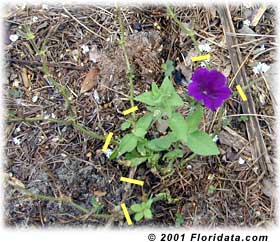
Take Care: Cut and Come Again
As we enter dog days of summer you might notice that some of your annual and perennial plants are totally crapping out. They have become masses of scraggly bare stems with few flowers and look so nasty that you want to compost them. Much better is to rehabilitate them with tough love. Cut back the stems to within 2 inches of the crown of the plant. Give them a shot of liquid fertilizer and then in a few weeks they'll be good as new and ready to put on another show of flowers. If you're getting lots of rain you'll also want to cut back rampant growth on plants like wisteria and ivy. If you have kudzu I recommend that you use a flame thrower and a herd of goats on it (but not simultaneously).
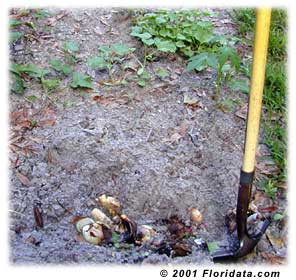
Take Care: Convenient Composting
If you are lazy like me and have sandy or otherwise crappy soil then you should try my conveniently carefree composting method. Essentially you dig a shallow hole in your garden, throw stuff in it and then cover it up. In the summertime the stuff will either rot or germinate very quickly, especially if the soil is moist. Many of our favorite kitchen composting wastes contain seeds so you can expect to see scores of cantaloupe, watermelon, orange and tomato seedlings spring forth. They are fresh and tender and green and full of hope so destroy them quickly by turning them under so that they too will rot into humus, the amazing organic substance that improves any type of soil.
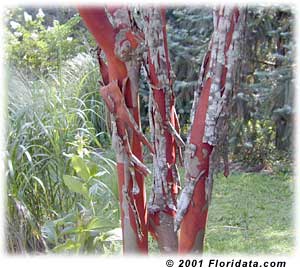
Crape's Appealing!
With all the crape myrtle's fine flowery display now going on you might not notice the stunning strip show being staged on its trunk. You should take time to enjoy this sensual shedding of smooth shreds of bark as this is one of the crape's most fascinating features. And while your there enjoying your crape, take a few minutes to prune off any spent flower heads. Your tree will love you for it and give you yet another round of flowers in a few weeks. This will also keep it from reseeding itself which results in dozens, possibly hundreds, of baby crapes for you to weed out - its well worth the effort.
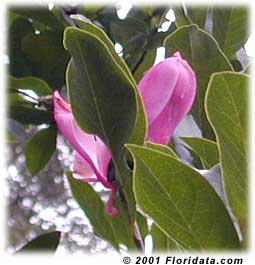
Freaks of Nature
This is a saucer magnolia that has become befuddled by the warm climate here in North Florida. Magnolia x soulangeana trees are deciduous hybrids that typically bloom in late winter or early spring before the foliage emerges. This one freaked and bloomed in mid-June. It put forth about a dozen blossoms and they looked very handsome against the deep green foliage! Perhaps it's trying to compete with nearby southern magnolias who are currently putting forth their big beautiful blossoms?

Things to Do (or not)
Because of the heat and mosquitoes I didn't spend much time out in the garden in June. I did manage to plant out a dozen Sabal minor and ten Sabal mexicana palm seedlings that I had germinated last year. Because of the nice rains of late they have happily settled into their new homes and THAT should be enough gardening effort to hold me until August. During July I expect to accomplish even less as it will be hotter, there will be even more mosquito's and I will be even lazier than ever. I resolve instead to go to the springs for many swims and to spend much quality time in the lawn chair. I hope that your July will be as enjoyable as the one that I plan to have. Thanks for enduring another rambling edition of my Gardener's Journal - you are persistent, courageous and generous with your time. Have a fun and productive month and be good and grow.
John Scheper 07/08/01